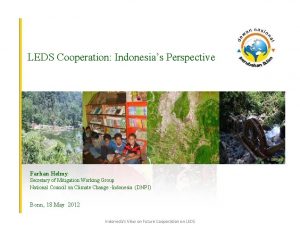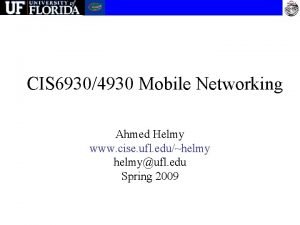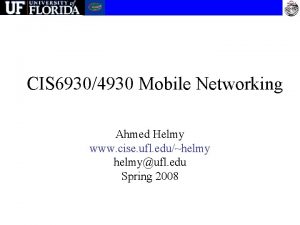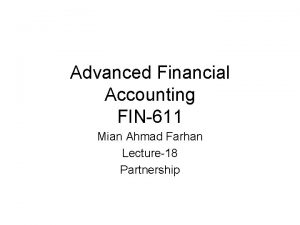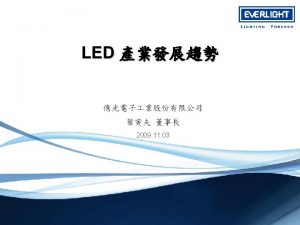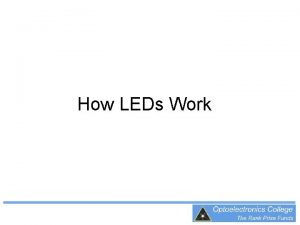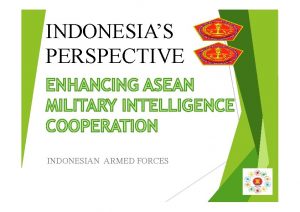LEDS Cooperation Indonesias Perspective Farhan Helmy Secretary of











- Slides: 11

LEDS Cooperation: Indonesia’s Perspective Farhan Helmy Secretary of Mitigation Working Group National Council on Climate Change -Indonesia (DNPI) Bonn, 18 May 2012 Indonesia's View on Future Cooperation on LEDS

Outline • Climate Change Policy Dynamics: How to mainstream Low Emission Development Scenarios into National Development Plan • Low Carbon Initiatives and Exercises: Lesson Learnt • Potential s Abatement Cost • Low Emission Development Growth Strategy (LCGS) • Population Dynamics and Climate Change • Promotion on Regional Cooperation Indonesia's View on Future Cooperation on LEDS

Mitigation Potentials and LED. Related Key Issues should be resolved in wide spectrum basis through framing the dialogue, stakeholder engagement and consensus, and MRV as a governance instrument LED is an “Institutional Transformation” Issue. NAMAs – National Appropriate Mitigation Actions Framing the Dialogue • To establish BAU baseline which is multi-sectoral business as usual as a basis for national mitigation actions: domestic (26%), international seeking support(15%) and credited NAMAs • To select effective and efficient mitigation actions(least abatement cost) through integrated and inclusive processes at national and sub-national levels. • To establish effective and efficient financial schema: public-private, market/non-market • “Proof of Concept” in the framework of low carbon economy (LCE)/sustainable development Stakeholder Engagement and Consensus on policy and technical issues • Ministries/line agencies, NGOs, etc. Governance • MRV as a means to measure commitment and performance • MRV as a means to facilitate coordination and planning, i. e database development Indonesia's View on Future Cooperation on

Emission Reduction Targets. Indonesian emission is expected to increase from 1. 72 to 2. 95 Gt. CO 2 e (2000 -2020). Proposed National Action Plan on GHG Emission Reduction(RAN-GRK) consist of 70 programs distributed among various sectors. Sectors Emission Reduction Plan (Giga ton CO 2 e) 26% 15% (total 41%) Forestry and Peat 0. 672 0, 367 Waste 0. 048 0. 030 Agriculture 0. 008 0. 003 Industry 0. 001 0. 004 Energy and Transportation 0. 038 0. 018 0. 767 0. 422 Agency Ministry of Forestry, Ministry of Environment, Ministry of Public Works, Ministry of Agriculture Ministry of Public Works, Ministry of Environment Ministry of Agriculture, Ministry of Environment Ministry of Industry Ministry of Transportation, Ministry of Energy and Mining, Ministry of Public Works Indonesia's View on Future Cooperation on LEDS

Climate Change Policy Dynamics • Presidential Instruction No. 10/2011 on Forest Moratorium. Development of REDD+ schemes including Indicative Moratorium maps • Presidential Decree No. 25/2011 on National Task Force for REDD+agency and related institutional development (finance and MRV) • Presidential Regulation No. 61/2011 on National Emission Reduction Plan (RAN-GRK). Covering 70 programs for 26/41% emission reduction plan across five main sectors(agriculture, forestry and peat, energy and transportation, industry, waste and other supporting activities) • Presidential Regulation No. 71/2011 on National GHG Inventory System. Regular information on th level, status and trend of GHG emission change and absorption, including national, and subnational carbon stock as well as GHG emission reduction • President Regulation on Spatial Planning: Kalimantan (Presidential Regulation 3/2012) Indonesia's View on Future Cooperation on LEDS

Macro Level Assessment : We have identified ways to reduce as much as 2. 3 Gt CO 2 e in cuts by 2030, using existing technologies. Put another way, we have identified specific ways (entirely executed, are to cut as much as 70 percent of our emissions by 2030. ) Reduction possibilities • 150 different measures have been identified that can be executed by the government, private sector and the community, which if all activated, add up to this 70 percent of total emissions in 2030. • The five biggest opportunities to reduce emissions are: 1). to prevent deforestation (570 Mt) (2). to prevent fires on peatland (310 Mt) (3). - to prevent oxidation of peatland through water management and rehabilitation (250 Mt) (4). - to implement and enforce sustainable forest management (SFM) (240 Mt) (5). to reforest marginal and degraded forests (150 Mt) • Better management of Indonesia’s land holds the key to cutting emissions and improving economic planning. It offers the possibility of reducing emissions by 1. 9 Gt CO 2 e by 2030.

Low Carbon Growth Strategies (LCGS). Exercises have been undertaking in developing low carbon growth plan in three provincial governments shows that Low carbon growth thinking has not been reflected in the traditional spatial planning process Key Elements: Sustainable economic development strategy • Competitive strengths and weaknesses • New sources of growth Sector strategies • Abatement opportunities, pilot projects, policies required • Palm oil, forestry, agriculture, coal, oil & gas District strategies • District’s size and land use • Emissions and potential for abatement • GDP and employment Implementation and enablers • Detailed action plan • Critical enablers required • Estimate of total costs Indonesia's View on Future Cooperation on

Populati on Dynamics. We have identified a number of population-based policy options for reducing GHG emissions which we believe merit further development and implementation: on Dynamics: Source: DNPI, BKKBN, UNFPA (2012), Policy Memo, “Population Dynamics and Climate Change in Indonesia” • • Enormous improvements can be made in energy efficiency in urban areas by better evidence-based spatial planning and allied interventions. Revitalizing the national family planning program can make a major contribution to Indonesia’s GHG mitigation efforts over the next 40 years, and beyond. Investing heavily in the education of today’s youth is an essential component of a successful mitigation strategy and a smooth transition to a green economy. Much can be done to promote – especially among the young and rising middle class – the benefits of green choices and sustainable lifestyles to help reverse the current steep rise in the country’s carbon intensity. Indonesia's View on Future Cooperation on

Knowledge sharing on LEDS. We have been initiating and actively involving in various networks at national and regional levels to share ideas, experiences, potential collaborations. • Series of Policy and Technical Dialogue: MRV, low carbon economy, policy and modelling, expert briefings on mitigation related issues, geo-spatial technology, 100 villages mapping initiative; green investment, innovation and productivity; service reform dialogue on CC(SEREDI) • Indonesia Carbon Update Network (ICU-Net, www. indonesiacarbonupdate. net) low carbon economy, green Innovation, policy and assessment, geospatial technology, knowledge Warehouse, open source initiative, MRV and ICU-net portal(www. indonesiacarbonupdate. net) • Sapporo Initiatives: strategic integrative research in the framework of low carbon economy; integration of science and capacity building efforts in economy-wide climate change mitigation research; geo-spatial technology; a new approach on mobilizing and deploying financial/technical resources (GO, private) • Asia Forum on Carbon Update (AFCU-Net, www. afcunetwork. net): networking and collaborative efforts on low carbon economy, technology and capacity building for scientific communities in the Asian region. • University Network on Climate Change: 19 universities, Trans Kalimantan University (more than 100 universities) • South East Asia Network on Climate Change Focal Points(SEAN-CC), UNEP. • Indonesia Climate Change Center (ICCC) (US-Indonesia Comprehensive Partnership), www. iccc-network. net • East Asia Carbon Partnership on Low Carbon Society Indonesia's View on Future Cooperation on LEDS

Promotion of Regional Cooperation • Encouraging strategic integrative research in responding to the immediate demand of climate change actions at regional, national and sub-national level, e. g REDD+, energy security • To utilize all related forum to elaborate and strengthen cooperation, including Southsouth Cooperation, and intensify development of indigenous technology to form a climate resilience society. • Policy information exchange and database development. A robust and comprehensive technical and scientific information is needed to fill the gaps among the models, particularly in the targeted areas that are significant emission contributor through data “collation”, “collection” and consensus building. • Establishing Expert Group in responding challenging demand from national and subnational level in the region • Linking LEDs into investment. A need for practical exercises on how we engage private/industry and other key stakeholders in a significant assessment. Indonesia's View on Future Cooperation on LEDS

Thank You!! Thank Indonesia's View on Future Cooperation on LEDS
